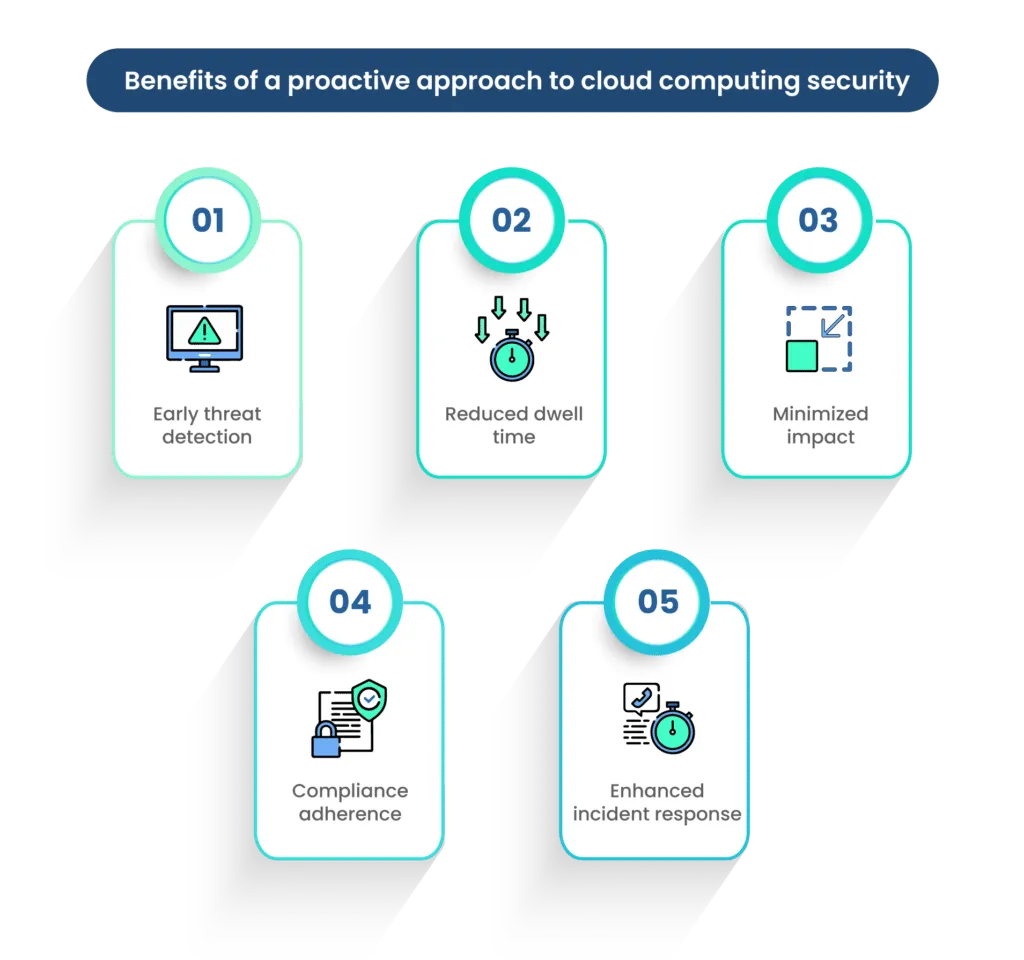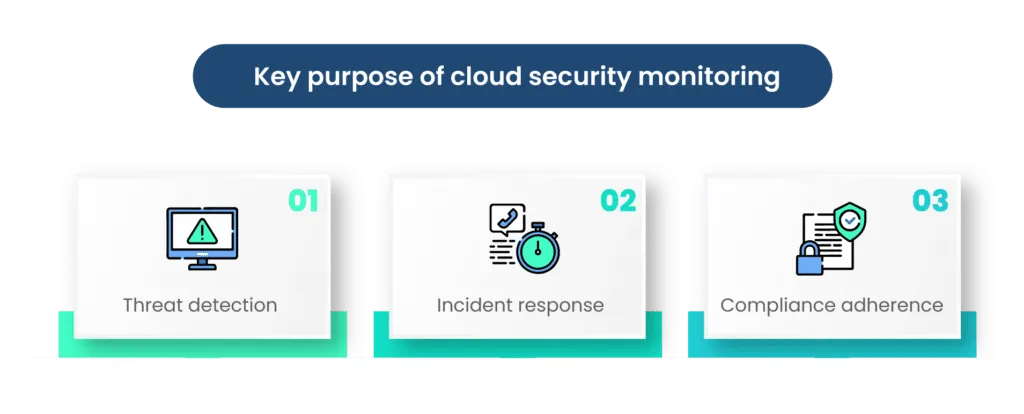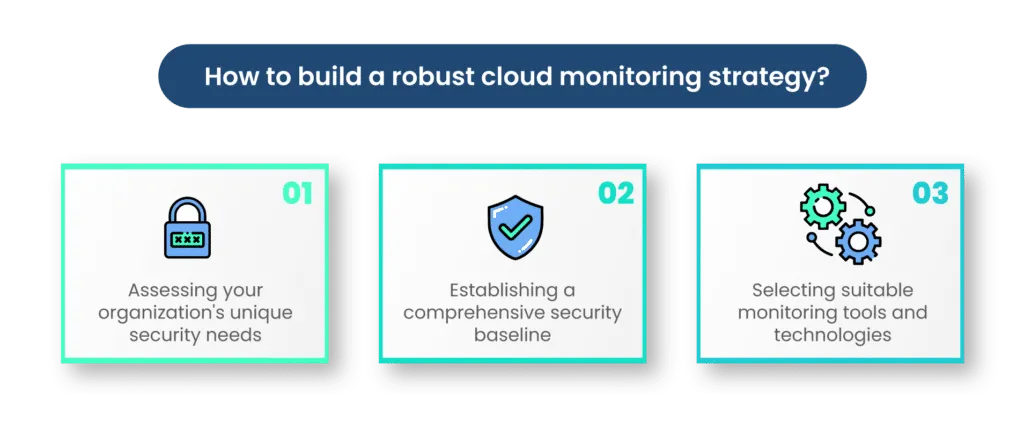Cloud security monitoring best practices

In today’s interconnected digital world, the shift to cloud computing has brought unprecedented advantages for businesses, including scalability, flexibility, and cost-efficiency. However, this migration to the cloud has also introduced a host of new security challenges.
Attack vectors and threats have evolved significantly, targeting cloud infrastructure, applications, and user data. Some key threats include:
- Data breaches: Unauthorized access to sensitive data stored in the cloud.
- Misconfigurations: Improperly configured services that expose data or create vulnerabilities. Gartner recently estimated that over 99% of cloud breaches by 2025 will be due to misconfigurations.
- Insider threats: Malicious activities or data theft perpetrated by individuals within the organization.
- Distributed Denial of Service (DDoS) attacks: Overwhelming cloud resources to disrupt services.
- Credential theft: Unauthorized access due to stolen credentials or weak authentication mechanisms.
The critical role of proactive cloud security monitoring
The reactive approach to cloud computing security is no longer sufficient in the face of rapidly evolving threats. Proactive security monitoring is a strategic necessity to safeguard your cloud infrastructure, applications, and sensitive data.
Rather than waiting for a breach to occur, proactive monitoring involves constant surveillance, threat detection, and timely response to potential incidents.

This approach offers several key advantages:
- Early threat detection: Proactive monitoring allows for the identification of potential threats before they escalate into major security incidents.
- Reduced dwell time: Dwell time refers to the duration between a breach occurring and its detection. Proactive monitoring aims to minimize this time, limiting the potential damage.
- Minimized impact: Swift response to detected threats can mitigate their impact and prevent data loss.
- Compliance adherence: Many industries have stringent regulatory requirements for cloud data security programs. Proactive monitoring helps maintain compliance by swiftly identifying and addressing vulnerabilities.
- Enhanced incident response: Proactive monitoring streamlines incident response processes by providing real-time insights and enabling immediate action.
By adopting proactive cloud security monitoring practices, organizations can create a resilient security posture that defends against emerging threats while maintaining the benefits of cloud computing.
What is cloud security monitoring?
Cloud security monitoring refers to the continuous process of tracking, analyzing, and responding to security-related events and incidents within a cloud environment. It involves the use of various tools, technologies, and strategies to detect potential threats, vulnerabilities, and unauthorized activities that could compromise the confidentiality, integrity, and availability of data and resources.
In the context of cloud computing, where traditional security perimeters are blurred and dynamic, proactive monitoring becomes paramount. It allows organizations to stay ahead of emerging threats and rapidly evolving attack vectors, ensuring the protection of sensitive assets and data.
What are the key objectives of cloud security monitoring?

Cloud security monitoring serves multiple essential objectives that collectively contribute to a robust cloud security posture management. So, what to look for in cloud security monitoring?
1. Threat detection
Monitoring enables the timely identification of anomalous activities, patterns, and behaviors that could signify a potential cloud computing security threat. This includes detecting unauthorized access attempts, suspicious network traffic, and unusual user behavior.
2. Incident response
In the event of a cloud computing security breach or incident, monitoring provides real-time insights that facilitate rapid response. Effective incident response minimizes the impact of breaches and helps prevent further compromise.
3. Compliance adherence
Many industries are subject to regulatory frameworks that mandate specific security measures. Proactive monitoring assists in maintaining compliance by identifying and addressing security gaps that could result in non-compliance.
Navigating shared responsibility models in cloud security
Most cloud service providers operate under a shared responsibility model, which delineates the division of security responsibilities between the provider and the customer. Understanding this model is crucial for effective cloud security monitoring:
1. Provider responsibilities
Cloud providers are responsible for securing the underlying infrastructure, including physical data centers, networking, and hardware. However, customers are still responsible for securing their data, applications, and configurations within the cloud environment.
2. Customer responsibilities
Customers must implement security measures for their applications, data, and access controls. This includes configuring firewalls, encryption, identity and access management (IAM), and monitoring.
By grasping the shared responsibility model, organizations can effectively design their cloud security monitoring strategy to address areas within their control and align with the provider’s security measures.
3 steps to build a robust cloud security monitoring strategy

An organization can follow the following steps to build an effective cloud security monitoring strategy.
A. Assessing your organization’s unique security needs
Every organization has its own set of assets, risks, and compliance requirements. Before embarking on a cloud security monitoring journey, conduct a thorough assessment of your organization’s unique cloud computing security needs:
- Asset inventory: Identify critical assets, sensitive data, applications, and services that require protection.
- Risk profile: Evaluate potential threats and vulnerabilities that could impact your cloud environment.
- Regulatory requirements: Determine which compliance standards apply to your industry and geographical region.
B. Establishing a comprehensive security baseline
A cloud computing security baseline acts as a foundation for monitoring efforts. It sets the standard configuration and behavior that you expect within your cloud environment:
- Configuration standards: Define and enforce secure configurations for cloud services, virtual machines, and network settings.
- Access controls: Implement strong identity and access management (IAM) policies, including role-based access controls (RBAC) and least privilege principles.
- Logging and auditing: Enable detailed logging for events, activities, and changes in your cloud environment.
- Patch management: Establish procedures for the timely application of security patches and updates.
C. Selecting suitable monitoring tools and technologies
Choosing the right monitoring tools and technologies is critical to the success of your strategy:
- Security Information and Event Management(SIEM): SIEM solutions aggregate and analyze security data from various sources, providing insights into potential threats and incidents.
- Intrusion Detection/Prevention Systems (IDS/IPS ): These systems monitor network traffic for suspicious activities and can automatically block or alert on potential threats.
- User and Entity Behavior Analytics (UEBA ): UEBA tools analyze user and entity behaviors to detect anomalies that could indicate unauthorized access or malicious activities.
- Cloud-native monitoring services: Cloud providers offer native monitoring services that collect and analyze data from their services, such as AWS CloudWatch and Azure Monitor.
Remember to align your tool selection with your organization’s needs, cloud environment, and technical capabilities.
What are the best practices for cloud security monitoring?

Now that we know how to build an effective cloud security monitoring strategy, let’s dive straight into the best practices for a robust cloud security monitoring strategy.
A. Continuous monitoring
The following points are covered under continuous monitoring for cloud computing security
- Real-time threat detection and alerts
Deploy monitoring solutions that provide real-time insights into your cloud environment. Set up alerts for suspicious activities, unauthorized access attempts, and potential breaches to enable swift response. - Automated response mechanisms
Integrate automation into your monitoring strategy. Automated responses can include isolating compromised resources, blocking malicious IP addresses, or triggering incident response workflows.
B. Multi-layered approach
The following is covered under the multi-layered approach
- Network security monitoring
Monitor network traffic for anomalies and potential threats. Intrusion detection and prevention systems (IDS/IPS) can help detect and block malicious activities. - Host-based monitoring
Implement host-based monitoring to track activities within individual servers and virtual machines. This helps identify unauthorized changes and malware infections. - Application and data-layer monitoring
Monitor the security of applications and data. Keep an eye on application behavior, access patterns, and data transfers to detect potential data breaches.
C. Identity and Access Management (IAM) monitoring
IAM monitoring involves the following steps:
- Monitoring privileged access
Monitor and audit privileged accounts and activities. Unusual actions by privileged users could indicate a security breach. - Detecting unusual user behaviors
Implement User and Entity Behavior Analytics (UEBA) to identify deviations from normal user behaviors, such as irregular login times or unusual data access patterns.
D. Data and compliance monitoring
The following two steps are included in the data and compliance monitoring
- Encryption and data protection monitoring
Monitor data encryption mechanisms to ensure that sensitive data is properly protected. Detect any unauthorized attempts to access encrypted data. - Compliance with industry standards (e.g., GDPR, HIPAA)
Regularly audit your monitoring strategy to ensure compliance with relevant industry standards and regulations. This includes maintaining proper audit trails and documentation.
E. Anomaly detection and behavioral analysis
This section includes the following:
- Establishing normal patterns of behavior
Collect and analyze data to establish baseline behaviors for users, applications, and systems. This helps in identifying deviations that could indicate a security incident. - Identifying deviations and potential threats
Implement advanced anomaly detection techniques to spot deviations from established patterns, which could be indicative of potential threats or attacks.
F. hreat intelligence integration
The organization should carry out the following steps in threat intellingence
- Utilizing threat feeds and intelligence sources
Incorporate threat intelligence feeds into your monitoring tools to stay updated on the latest threat landscape. This enables proactive detection of emerging threats. - Enhancing monitoring based on current threat landscape
Adjust your monitoring strategy based on threat intelligence. Prioritize monitoring for threats that are currently active or relevant to your industry.
G. Incident response integration
Following steps are included in this section
- Automated incident escalation and orchestration
Set up automated workflows for incident escalation. This ensures that the right stakeholders are notified promptly when a potential incident is detected. - Seamless transition from detection to response
Integrate your monitoring tools with your incident response processes. This allows for a seamless transition from detection to immediate response actions.
H. Conducting regular security assessments
Regular security assessments are essential to ensure the ongoing effectiveness of your monitoring strategy:
- Vulnerability assessments: Regularly scan your cloud environment for vulnerabilities in applications, services, and configurations.
- Penetration testing: Conduct ethical hacking exercises to identify potential weaknesses and test the efficacy of your monitoring systems.
- Red team exercises: Simulate real-world attacks to evaluate your team’s response capabilities and the performance of your monitoring tools.
I. Establishing KPIs and metrics for monitoring effectiveness
Measuring the success of your monitoring strategy requires defining key performance indicators (KPIs) and metrics:
- False positive rate: Measure the percentage of alerts that turn out to be false positives.
- Mean Time to Detect (MTTD): Calculate the average time it takes to detect security incidents.
- Mean Time to Respond (MTTR): Determine the average time it takes to respond to and mitigate security incidents.
- Coverage ratio: Assess the proportion of your cloud environment being effectively monitored.
J. Continuous improvement through feedback loops
Adaptation and improvement are ongoing processes in cloud security monitoring:
- Incident post-mortems: Conduct thorough analyses of security incidents to understand what went wrong and how to prevent similar incidents in the future.
- User feedback: Encourage your security team to provide feedback on the efficacy of monitoring tools and processes.
- Benchmarking: Compare your monitoring practices with industry best practices and adjust accordingly.
What are the challenges and pitfalls to avoid in cloud security monitoring strategy?

No strategy comes without its own challenges. Let’s discuss the challenges that an organization might face while implementing cloud security monitoring strategy.
A. Alert fatigue and false positives
One of the most common challenges in security monitoring is alert fatigue, where the sheer volume of alerts overwhelms security teams. False positives—alerts triggered by benign events—contribute to this problem. To mitigate these challenges:
- Tune alerts: Fine-tune monitoring rules to reduce false positives. Ensure that alerts are triggered only for meaningful events.
- Prioritize alerts: Assign severity levels to alerts, focusing on those that pose the highest risk to your environment.
- Automate responses: Implement automated responses for routine alerts to reduce the burden on security teams.
- Regular review: Periodically review and refine alerting rules based on actual incidents and feedback from analysts.
B. Lack of skilled personnel and training
Effective cloud security monitoring requires skilled personnel who understand cloud infrastructure, security concepts, and threat detection. To address this challenge:
- Training programs: Invest in training programs to enhance the skills of existing staff or hire personnel with relevant expertise.
- Certifications: Encourage team members to pursue industry-standard cloud security certifications and certification cloud monitoring.
- Cross-training: Foster a culture of knowledge sharing within your security team to ensure collective expertise.
C. Inadequate tool configuration and maintenance
Deploying monitoring tools is just the beginning; regular maintenance and proper configuration are crucial for their effectiveness:
- Configuration review: Regularly review and update tool configurations to align with changes in your cloud environment.
- Patch and update management: Stay current with tool updates and patches to benefit from the latest features and security improvements.
- Automate maintenance: Automate routine maintenance tasks to ensure consistent tool performance.
Future of cloud security monitoring
A. AI and Machine Learning advancements
The integration of artificial intelligence (AI) and machine learning (ML) technologies is revolutionizing cloud security monitoring:
- Behavioral analysis: AI and ML can identify patterns and anomalies in user behavior that might not be evident through traditional rule-based approaches.
- Predictive analysis: These technologies enable the prediction of potential security incidents by analyzing historical data and current trends.
- Automated decision-making: AI-driven systems can make real-time decisions, enabling faster response to threats and reducing human intervention.
B. Integration of automation and orchestration
Automation and orchestration are becoming integral parts of effective cloud security monitoring:
- Automated response: Immediate response actions, such as blocking suspicious IP addresses or quarantining compromised resources, can be triggered automatically.
- Orchestration of workflows: Incident response workflows can be orchestrated to ensure that the right teams are engaged in a coordinated manner.
- Playbooks: Develop pre-defined response playbooks to guide security analysts through a consistent and effective incident response process.
C. Anticipating emerging threats and adapting monitoring strategies
The landscape of cyber threats is constantly evolving. To stay ahead of these threats, organizations need to be proactive:
- Threat intelligence platforms: Leverage threat intelligence platforms that provide real-time updates on the latest threats, vulnerabilities, and attack techniques.
- Adaptive monitoring: Develop monitoring strategies that can quickly adapt to new threats and attack vectors.
- Threat hunting: Proactively search for signs of potential threats in your environment, even before alerts are triggered.
Conclusion
In the ever-changing world of cloud computing security, proactive monitoring isn’t just an option—it’s a must. Protecting your digital assets and data requires a flexible and vigilant approach that matches the dynamic nature of modern threats. By following the best practices in this blog, you can create a strong cloud computing security monitoring plan that effectively defends against various cyber threats.
Start your journey towards a safer cloud environment with knowledge and action. Understand the importance of cloud security monitoring, adopt a multi-layered approach, and leverage AI and automation. Remember that cloud computing security is an ongoing process, not a final destination. Success involves assessing risks, adapting to new threats, and committing to continuous improvement.
As you navigate this landscape, prioritize collaboration, ongoing learning, and sharing information within your security team. Keep up with industry trends, seek training opportunities, and cultivate a culture of security awareness. This ensures that your cloud computing security monitoring strategy remains up-to-date and effective.
In a world of advancing technology and evolving threats, your dedication to cloud computing security monitoring is crucial for safeguarding your organization’s digital assets, reputation, and overall success.
For more information on how Scrut can assist you in cloud computing security, log in to our official website here.
FAQs
1. What is cloud computing security monitoring?
Cloud security monitoring is the continuous process of tracking, analyzing, and responding to security-related events and incidents within a cloud environment. It involves using various tools and strategies to detect potential threats and vulnerabilities that could compromise data and resources.
2. Why is proactive security monitoring important in the cloud?
Proactive security monitoring is essential in the cloud due to the dynamic and evolving nature of threats. It helps detect and respond to potential incidents before they escalate, reducing damage and minimizing downtime.
3. How do I ensure the effectiveness of my cloud computing security monitoring strategy?
Establish key performance indicators (KPIs) and metrics to measure monitoring effectiveness. Monitor false positive rates, mean time to detect (MTTD), mean time to respond (MTTR), and overall coverage ratio.


















